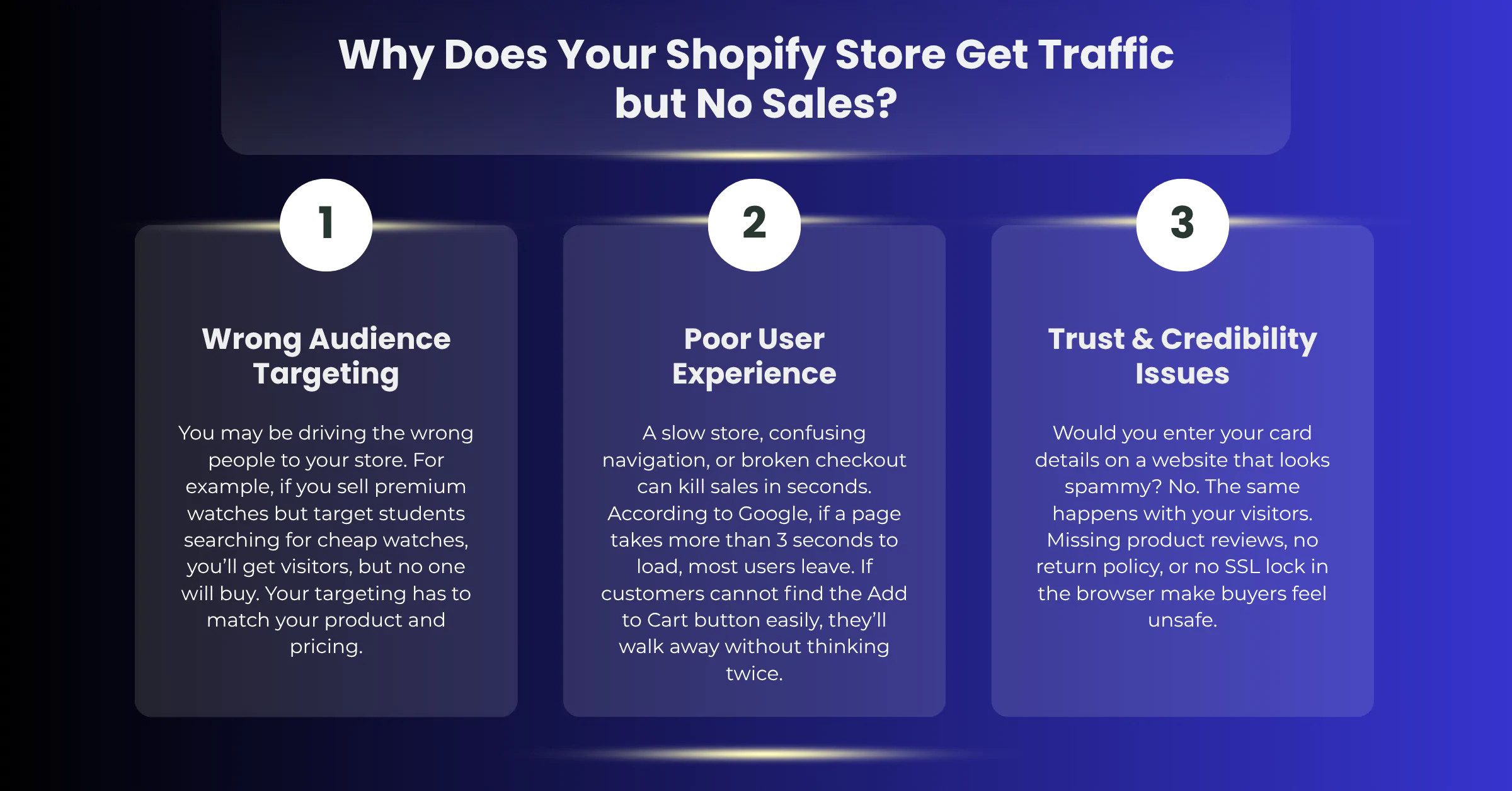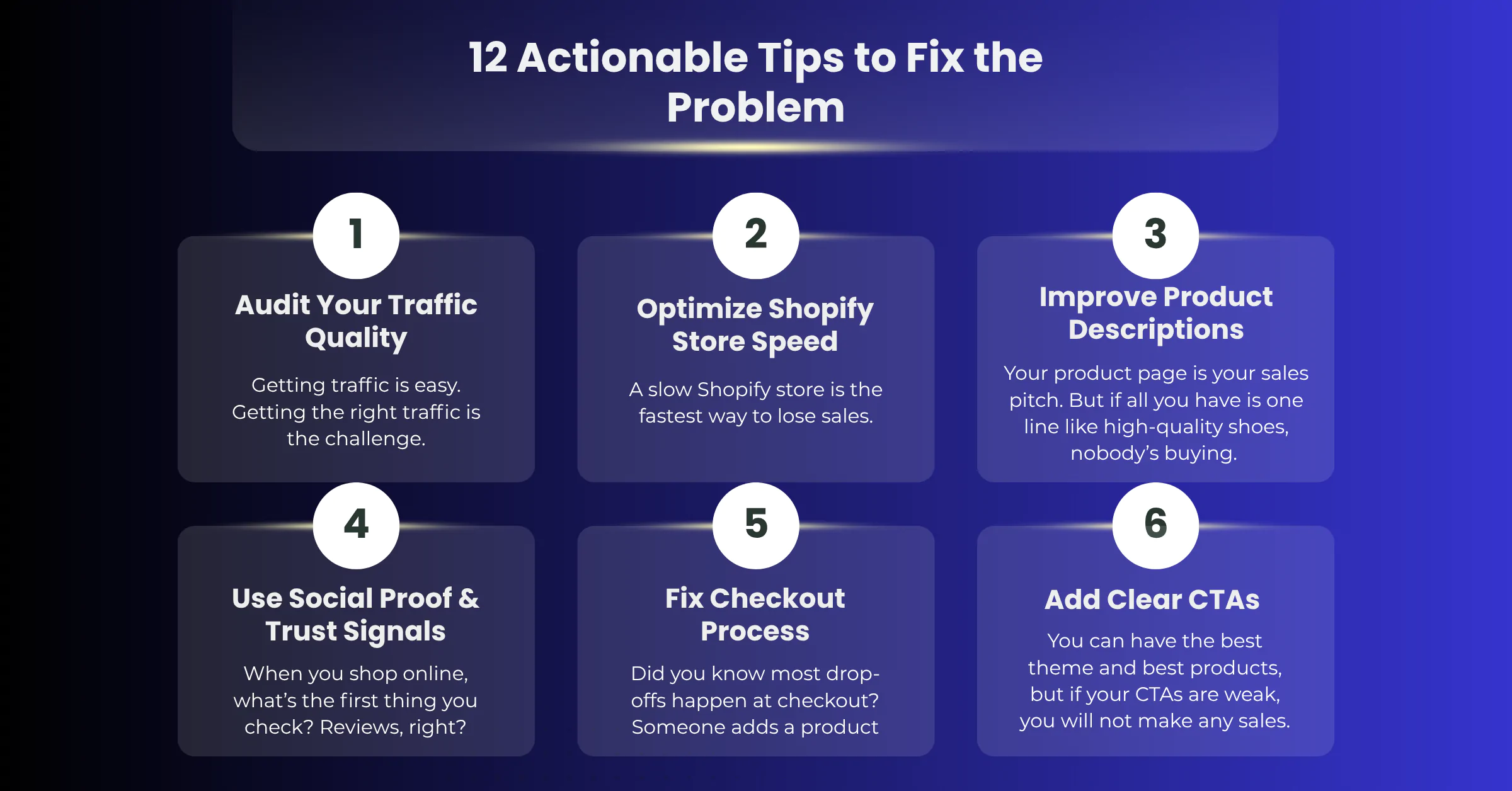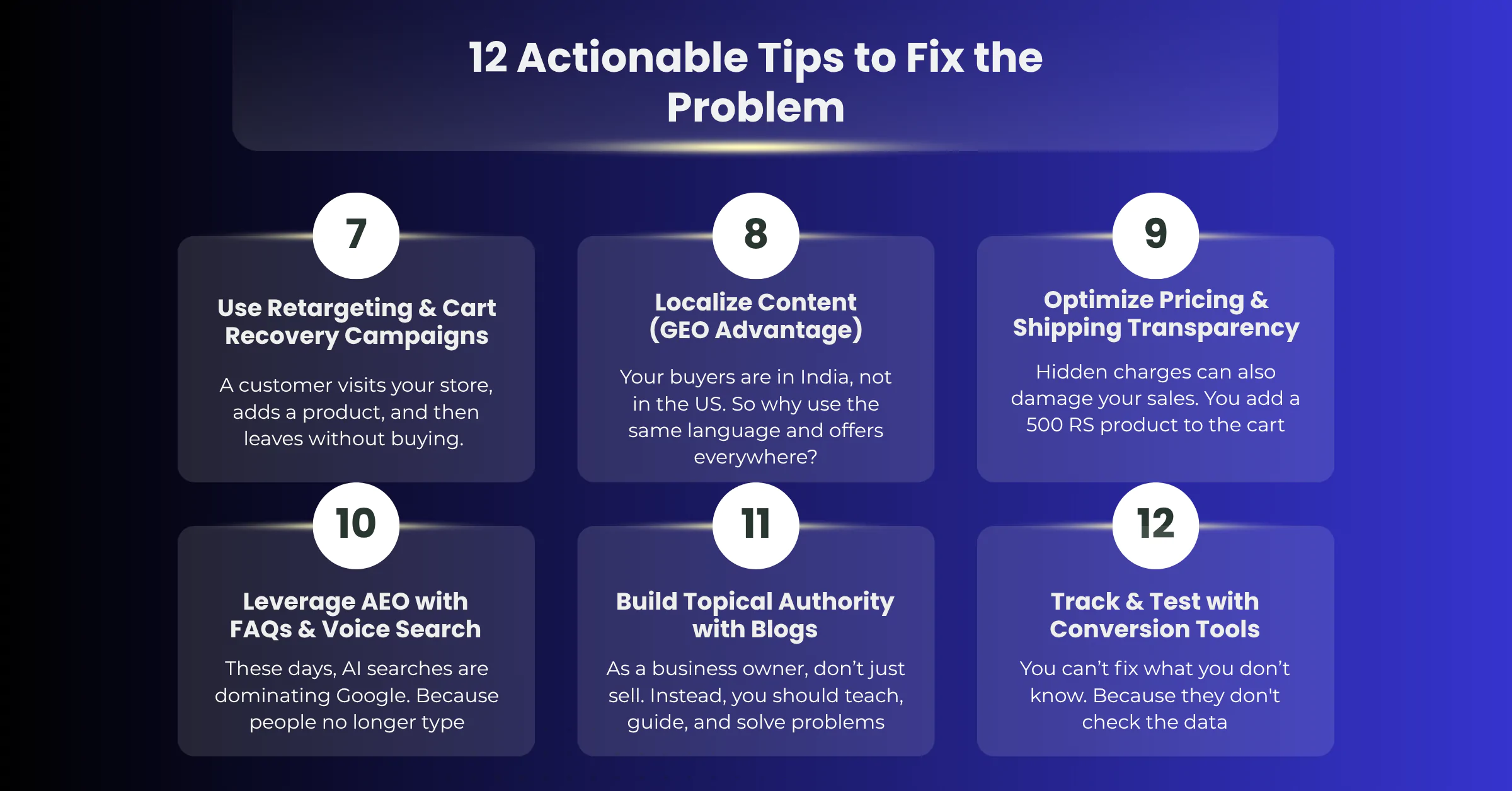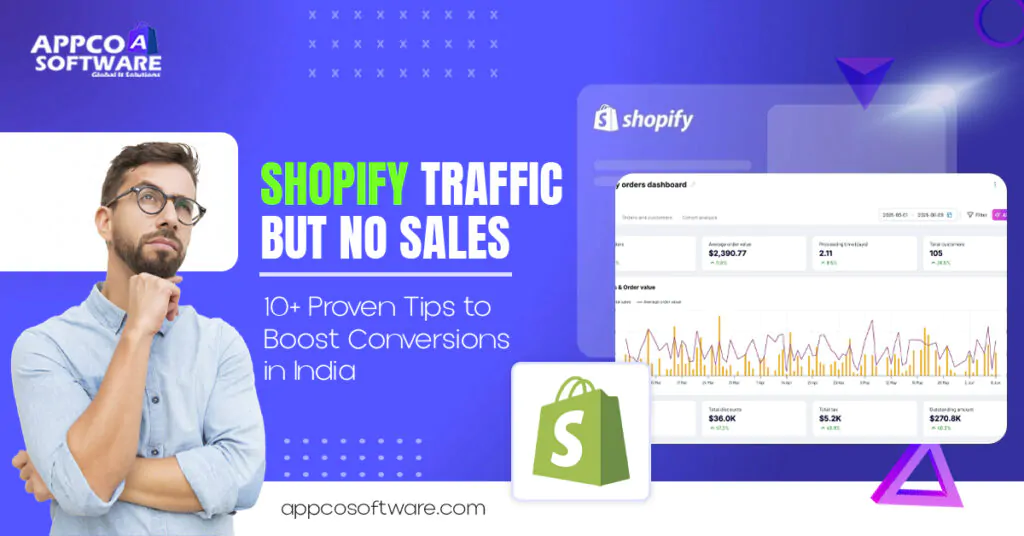You open your Shopify dashboard and see traffic coming in every day. Sounds good, right? But when you check the sales numbers, it’s almost zero. That frustration is real. Many Shopify store owners in India face the same problem: traffic but no sales.
The average Shopify conversion rate is 1.4%–2.5%. That means out of 100 people visiting your store, only 2 or 3 actually buy. Now, if your store is not optimized, your conversion rate could be even lower, which means wasted ad spend, wasted effort, and wasted opportunities.
2025 is not the time to ignore this. Google is pushing more updates, AI overviews are changing how people shop, and voice searches are becoming common in India. You cannot just focus on bringing visitors; you have to focus on turning them into buyers.
This guide will give you 10+ proven tips to fix the Shopify traffic but no sales issue. These Shopify conversion tips are designed for Indian stores to improve both traffic quality and sales numbers. From Shopify site speed optimization to improving your product pages, from SEO fixes to CRO strategies, you’ll see how small changes can bring a big jump in sales.
Also Read – Shopify Speed Optimization: Reduce Bounce Rates and Boost Revenue
Why Does Your Shopify Store Get Traffic but No Sales?

So, your SEO is taking people to your store, but they’re not buying anything. Why does this happen? There are a few common reasons:
1. Wrong Audience Targeting
You may be driving the wrong people to your store. For example, if you sell premium watches but target students searching for cheap watches, you’ll get visitors, but no one will buy. Your targeting has to match your product and pricing.
2. Poor User Experience
A slow store, confusing navigation, or broken checkout can kill sales in seconds. According to Google, if a page takes more than 3 seconds to load, most users leave. If customers cannot find the Add to Cart button easily, they’ll walk away without thinking twice. This is where Shopify site speed optimization and clear design make a big difference.
3. Trust & Credibility Issues
Would you enter your card details on a website that looks spammy? No. The same happens with your visitors. Missing product reviews, no return policy, or no SSL lock in the browser make buyers feel unsafe. Trust badges, customer reviews, and a clean design build confidence and push people to complete the purchase.
12 Actionable Tips to Fix the Problem

Tip 1: Audit Your Traffic Quality
Getting traffic is easy. Getting the right traffic is the challenge. If you’re attracting people who are just browsing but never buying, your store will always struggle. Open Google Analytics or Search Console and check your top traffic sources. Are visitors staying on your site? Are they checking product pages or bouncing back?
If you’re ranking for keywords like cheap shoes but selling premium sneakers, the mismatch kills conversions. You should fix this issue by aligning your keywords with buyer intent. Instead of chasing everyone on the internet, focus on keywords like buy running shoes online India or best sneakers under 5000 rupees. If you’re unsure about audits, you can always reach out to a Shopify CRO expert in India to help analyze your traffic sources.
Tip 2: Optimize Shopify Store Speed (SEO + Core Web Vitals)
A slow Shopify store is the fastest way to lose sales. Google’s September update made page speed and Core Web Vitals even more important for rankings. And you might be aware that if your store takes more than 3 seconds to load, you are not going to make any sales.
You can check your speed with tools like PageSpeed Insights, GTmetrix, or Pingdom. You should compress heavy images, use lazy loading, and remove unused apps or code. If you’re not confident, hire a Shopify development company in India to run a Shopify site audit and fix speed issues.
Tip 3: Improve Product Descriptions with AEO-Style Content
Your product page is your sales pitch. But if all you have is one line like high-quality shoes, nobody’s buying. Customers want answers. And this is why we consider AEO-style content. You are supposed to write your product descriptions in a conversational tone.
You can add short FAQs like:
- Does this shirt shrink after the first wash?
- Is COD available at my location?
- How many days for delivery in Mumbai?
Also, add schema markup so Google can pick these answers and show them in snippets.
Tip 4: Use Social Proof & Trust Signals
When you shop online, what’s the first thing you check? Reviews, right?. That’s how customers think, too. If your Shopify store doesn’t show reviews, ratings, or even small trust badges, people hesitate to buy. And in your case, you should also add real customer reviews, product photos shared by users, and even short testimonials. A simple Verified Purchase tag builds huge trust. Don’t ignore return and refund policies; in India, most customers read them before hitting Buy Now. Also, add trust signals like SSL (https:// lock), COD badges, and secure payment icons. These small things make your store look reliable. If people feel safe, they’ll buy.
Tip 5: Fix Checkout Process (Mobile-first GEO Optimization)
Did you know most drop-offs happen at checkout? Someone adds a product, but then, they disappear. Because the checkout page or process is not clear. For this very reason, you’re supposed to keep checkout short and simple. And use one-click checkout wherever possible. In India, add UPI, Paytm, PhonePe, and Cash on Delivery (COD). If you force only card or net banking, you’ll lose half your buyers. Also, optimize checkout for mobile first. More than 70% of Shopify traffic in India comes from mobile phones only. To get more sales, make sure the buttons are big enough, payment forms are easy to fill out. And most importantly, the whole process is easy and smooth. These small checkout tweaks can increase sales on Shopify stores without spending extra on ads.
Tip 6: Add Clear CTAs (Call-to-Actions)
You can have the best theme and best products, but if your CTAs are weak, you will not make any sales. As a Shopify business owner, you should keep in mind that the Add to Cart and Buy Now buttons must be visible. You should not hide them under animations or banners. Instead, you should use bright colors that match your theme but still catch the eye. Also, test the words. Sometimes Shop Now works better than Add to Cart. And also, you should add CTAs in multiple spots: product page, category page, and even in the cart. A small nudge at the right place can push buyers to take action.
Tip 7: Use Retargeting & Cart Recovery Campaigns

A customer visits your store, adds a product, and then leaves without buying. Should you forget them? No! Retargeting brings them back. This is why you should set up cart recovery emails, WhatsApp reminders, or SMS alerts. A simple: hey, you left this in your cart, complete your order now message is going to help you. Add a small discount or free shipping to sweeten the deal. Also, run retargeting ads on Facebook, Instagram, and Google. People already know your brand; one reminder can push them to buy. In India, WhatsApp campaigns are especially powerful. And in India, every single person uses WhatsApp these days. If you’re not confident about the theme, work with a Shopify website design company that understands both UX and CRO.
Tip 8: Localize Content (GEO Advantage)
Your buyers are in India, not in the US. So why use the same language and offers everywhere? Localize your store content. For example, if you run ads in Delhi, show Free Delivery in Delhi NCR. If you target Mumbai, mention COD available across Mumbai. You should use local languages too, like Hindi, Marathi, Tamil, and Gujarati. Voice search queries in regional languages are growing fast. Also, optimize content for local SEO keywords like Shopify development company in Jaipur or Shopify site audit in Mumbai. Google now shows results based on location.
Tip 9: Optimize Pricing & Shipping Transparency
Hidden charges can also damage your sales. You add a 500 RS product to the cart, and suddenly, at checkout, it becomes 650 RS with shipping. As a customer, you also don’t like that. This is why you should be clear about pricing upfront. And show shipping costs on the product page itself. If you can, offer free shipping on a minimum order value. It’s better to adjust product pricing slightly than to surprise customers at the end. Also, use tools that show delivery timelines: delivery in 2–3 days builds trust. People like clarity. And if you’re targeting metro cities, highlight same-day or next-day delivery.
Tip 10: Leverage AEO with FAQs & Voice Search
These days, AI searches are dominating Google. Because people no longer type only, but also buy shoes online. But these days, people ask full questions like:
- Which are the best running shoes under 2000 rupees in India?
- Why is my Shopify order taking so long?
That’s where AEO (Answer Engine Optimization) helps. You should also add FAQs on your product and category pages. Write in a question-answer format just like people ask on Google. Also, use schema markup so Google knows these are FAQs.
As you are aware that voice search is huge in India, especially in Hindi and regional languages. For this reason, you should optimize your content for natural language. Strong Shopify store SEO in India now means not just ranking, but also being ready for voice and AI search.
Tip 11: Build Topical Authority with Blogs
As a business owner, don’t just sell. Instead, you should teach, guide, and solve problems of your target audience. That’s how you build authority. You can start a blog on your Shopify store.
Write guides like:
- How to choose the right kurta size online
- Best skincare routine for Indian summers
You can use your products inside these blogs naturally. Also, link one blog to another. This internal linking tells Google you know the full topic, not just one piece. Over time, this builds topical authority.
Tip 12: Track & Test with Conversion Tools
You can’t fix what you don’t know. Because they don’t check the data, most Shopify store owners don’t know why their sales are low. You can use tools like Hotjar or Microsoft Clarity to see where users click, scroll, or drop off. And use GA4 and Shopify Analytics to track traffic sources, conversion rates, and cart abandonments. Also, do A/B testing. For example, test Buy Now vs Add to Cart, or red CTA button vs green CTA button. Sometimes these small changes can bring big results.
Also Read – SEO vs AEO vs GEO
The Final Say
Getting traffic but not making sales on your Shopify store is a common problem. It doesn’t mean your store has failed. It only shows that something is not in place, maybe the wrong visitors are landing, maybe the site is too slow, or maybe the checkout flow is confusing. The good thing is, all of this can be corrected.
Right now, in 2025, Google search is changing fast. Normal SEO is still important, but you also have to think about AEO (Answer Engine Optimization) and GEO (Generative Engine Optimization). People use voice search, AI tools, and Google AI Overviews. If your store is not ready for these, you will miss sales. At the same time, simple things like fast loading, clear product pages, proper CTAs, and customer reviews help you turn visitors into buyers.
If you want real results, not just traffic numbers, then take action today. Book a free Shopify SEO & Conversion Audit with us. At Appco Software, we work with Shopify stores across Jaipur, Delhi, Mumbai, and Lucknow. We know what works in India and how to turn clicks into customers.
Shopify Traffic But No Sales FAQs
1. Why am I getting traffic but no sales?
This is the most common issue. Traffic is coming, but maybe the visitors are not the right ones. Or they land on your site, and it’s slow, confusing, or missing trust signals like reviews and return policies. Do a proper Shopify site audit to check speed, navigation, and checkout flow.
2. Why is my Shopify conversion rate so low?
Shopify’s average conversion rate is just 2–3%. If yours is lower, don’t panic. Check product descriptions, images, CTAs, and loading time. Even small things like the Add to Cart vs Buy Now button make a big difference. Also, see if your pricing or shipping costs are turning people away at checkout.
3. Can Shopify handle high traffic?
Yes, Shopify can handle huge traffic. Many top Indian and global brands run on it. The issue is not Shopify itself—it’s your store setup. If your theme is heavy, apps are not optimized, or speed is ignored, your site can lag when traffic spikes. That’s where Shopify site speed optimization comes in.
4. How to get a higher conversion rate on Shopify?
Focus on basics.
- Write clear, benefit-driven product descriptions.
- Add reviews, trust badges, and easy return options.
- Fix checkout, UPI, COD, Paytm, and Razorpay work best in India.
- Optimize site speed, because slow sites harm your sales.
- Retarget visitors with WhatsApp, email, or SMS reminders.
5. Why is my Shopify not getting sales?
If traffic is coming but no orders, maybe you’re targeting the wrong people. For example, if you sell premium watches but your keywords are attracting cheap watches under 500 rupees, those visitors will never buy. Check your SEO keywords and ads targeting. Align with buyer intent, not just random traffic.
6. Why do so many Shopify stores fail?
Most fail because owners stop after setup. They launch the store, but don’t optimize speed, SEO, content, or checkout. Some copy everything from competitors without thinking of their own niche.
7. How do I get more sales on Shopify?
To get more sales, make the store customer-friendly.
- Add FAQs, size guides, and product videos.
- Keep mobile browsing smooth (India has 80% mobile traffic).
- Use retargeting ads for abandoned carts.
- Write blogs and guides to rank on Google.
- Work with a Shopify SEO expert if you’re not sure where to start.

